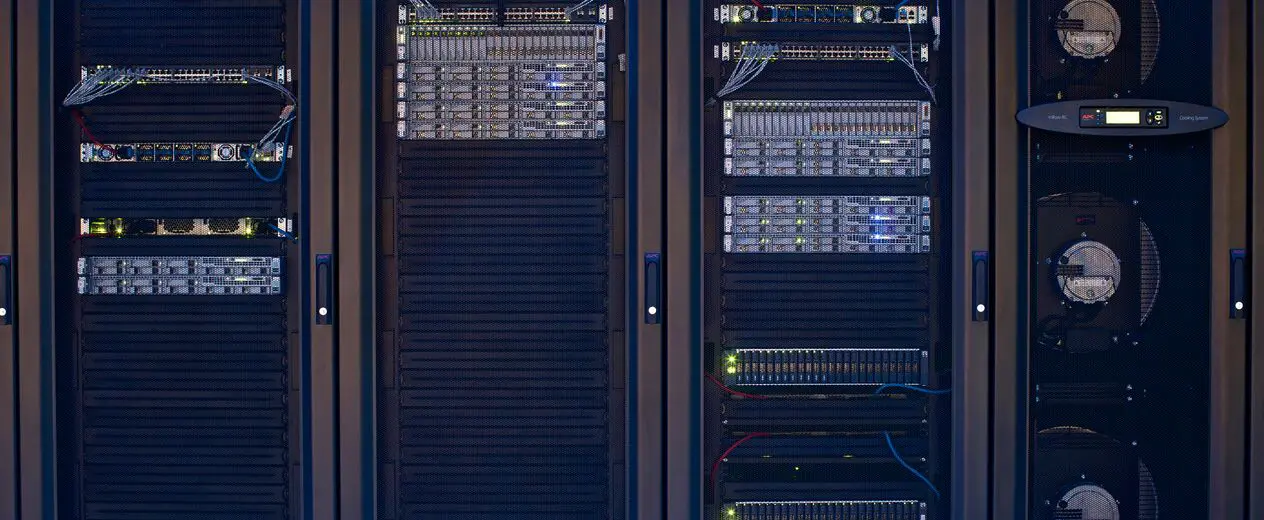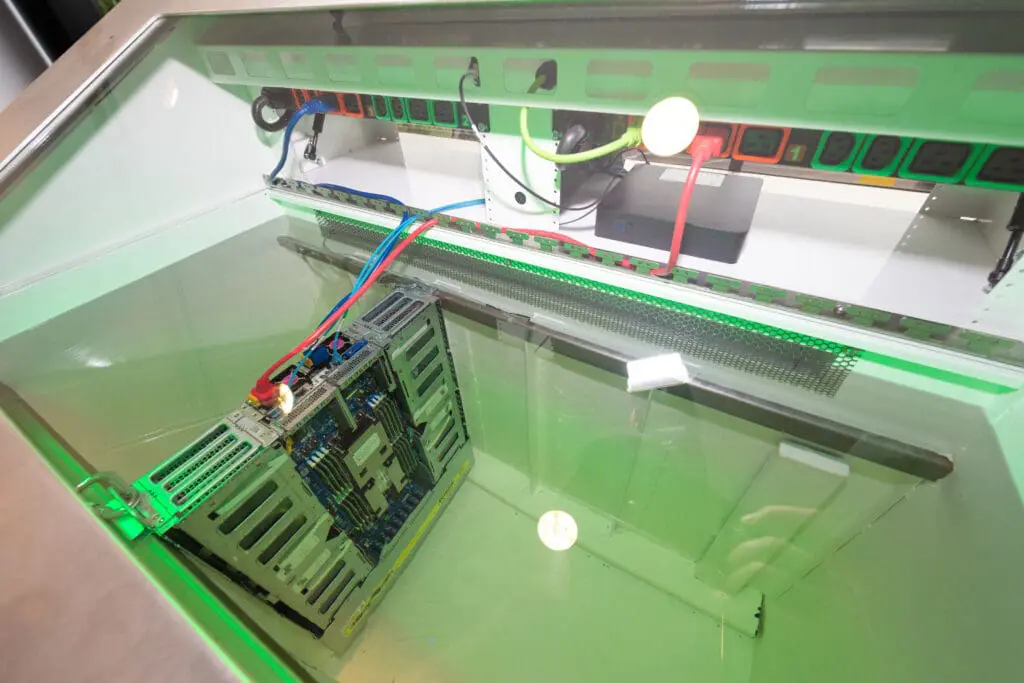Advanced cooling technologies boost efficiency and performance in High-density Data Centres

High-Density Data Centre efficiency with Direct Liquid to Chip and Immersion cooling
As the world continues its digital transformation, the demand for powerful, high-density computing solutions is rising at an unprecedented rate. To meet these growing needs, organisations are turning to innovative cooling technologies that help manage the heat generated by high-performance servers.
Two leading solutions—Direct Liquid to Chip (DL2C) cooling and Liquid Immersion cooling—are becoming increasingly necessary in supporting efficient, sustainable, and high-density compute requirements.
This article explores these technologies, their benefits, and how companies like Interactive are adopting them to lead the market in a rapidly evolving landscape.
“High-density cooling solutions, like liquid cooling, allow us to efficiently handle up to 100 kilowatts in a single rack compared to spreading that load across 10 racks at 10 kilowatts each. This approach is not only cost-effective for customers, but it also brings efficiency gains, as liquid cooling is more effective than traditional air-cooling methods. In short, we don’t need to rely on blowing cold air through servers anymore—we can do it more efficiently with liquid cooling.” - Ben Taylor, National Data Centre Manager at Interactive
The growing demand for efficiency in High-Density Data Centres
In high-density data centres, the need for more effective cooling solutions has become essential. As modern IT equipment becomes more powerful, it also consumes more energy and generates significant amounts of heat. Traditional air-cooling methods struggle to manage the thermal output generated by racks exceeding 10 kilowatts. The industry is now shifting towards advanced cooling technologies that can handle these high demands while optimising energy consumption and space usage.
Welcome to the world of DL2C and Liquid Immersion cooling. Let’s put them both under the microscope.
What’s Direct Liquid to Chip (DL2C) cooling?
Direct Liquid to Chip (DL2C) cooling is a technology where liquid coolant is circulated through pipes attached directly to the chips in the servers. This method targets the most heat-intensive components—like processors and GPUs—efficiently managing heat dissipation. DL2C cooling allows for higher-density server configurations without requiring additional space, making it a versatile solution for both new and existing data centres. By reducing reliance on traditional air cooling, DL2C enhances energy efficiency and lowers cooling costs.
What is Immersion cooling?
Immersion cooling works by submerging servers in a tank filled with non-conductive liquid that absorbs heat from the components. This approach can handle extremely high-density configurations, dissipating up to 100 kilowatts of heat per rack. One key difference between immersion cooling and DL2C is that immersion cools the entire server, while DL2C focuses on specific components. Though adoption of immersion cooling has been slower due to concerns about hardware compatibility, it’s gaining traction due to its ability to support advanced workloads such as AI and machine learning.

Comparison at a glance:
Immersion cooling vs. Direct Liquid to Chip cooling
Immersion cooling: This method involves submerging servers in a tank filled with a non-conductive liquid that absorbs heat directly from the components. It can effectively manage up to 100 kilowatts of heat. Although immersion cooling has seen limited adoption due to concerns about compatibility with existing hardware, the perceived risks of using liquid near sensitive electronic equipment are not an issue. The liquid used is a specialised dielectric (non-conductive) solution, ensuring effective heat dissipation without the risk of short-circuiting. Both DL2C and immersion cooling will require chilled water, so it’s important to consider this as a common requirement for both solutions.
Direct Liquid to Chip cooling: This technology cools servers using liquid that is circulated through pipes directly attached to the chips. This allows for high-density configurations without requiring substantial physical space. Unlike immersion cooling, direct liquid to chip systems can coexist alongside traditional air-cooled servers, making it a more versatile option for many data centres. Both DL2C and immersion cooling will require chilled water, so it’s important to consider this as a common requirement for both solutions.
Key Benefits:
How DL2C and Immersion cooling boost High-Density Data Centre efficiency
Energy efficiency
Both direct liquid-to-chip (DL2C) and immersion cooling technologies provide a significant boost to the energy efficiency of data centres, addressing the growing power demands of high-density computing environments. Traditional air-cooling systems typically have a Power Usage Effectiveness (PUE) of around 1.5 to 1.8, meaning nearly half of the energy consumed is used for cooling rather than computing. In contrast, liquid cooling solutions reduce PUE closer to 1.0, ensuring that the majority of energy consumption is dedicated to actual compute power, not cooling.
Energy reduction is further enhanced by eliminating the need for server fans required for air cooling. DL2C and immersion cooling minimise the power consumption associated with cooling operations, thereby improving PUE. This enhanced efficiency helps mitigate rising power demands, resulting in lower operational costs and reduced carbon footprints, while also supporting corporate sustainability objectives. By optimising energy consumption, DL2C and immersion cooling play a key role in meeting both performance and environmental targets in today’s data centres.
High-Performance computing
High-density cooling technologies are crucial for supporting high-performance computing (HPC) environments, particularly in sectors like finance, research, and healthcare. These industries often require powerful computing systems to process vast amounts of data, which generate immense heat. By efficiently managing thermal loads, DL2C and Liquid Immersion cooling ensure that performance is not compromised, allowing data centres to push the limits of their computing capabilities.
“Universities and research institutions are another key market, given their need for intense processing power to support data-heavy research projects. The healthcare sector, too, is beginning to recognise the potential of these solutions as they increase their reliance on high-performance computing to drive innovation in diagnostics, imaging, and data analysis.” - Ben Taylor, National Data Centre Manager at Interactive
Cost optimisation
Cost savings are another major benefit of liquid cooling technologies. High-density solutions allow organisations to pack more compute power into fewer racks, reducing the need for expansive facilities and additional infrastructure. This consolidation not only lowers capital expenditures on hardware and space, but also reduces ongoing operational costs related to cooling and energy consumption. By investing in advanced cooling technologies, businesses can optimise their data centre footprint while maximising compute power.
Challenges to adoption
It’s essential to have a clear conversation with customers about the “why” and “how” to support their high-density compute needs and address the concerns that may be holding them back, according to Ben Taylor, Interactive’s National Data Centre Manager.
“One major challenge is the perceived risk associated with new technologies like immersion cooling and direct liquid-to-chip cooling. Many organisations worry about the long-term viability and reliability of these solutions, particularly around equipment warranties, maintenance complexities, and the potential for unexpected failures in critical environments.” – Ben Taylor, National Data Centre Manager at Interactive
Additionally, integrating these systems into existing infrastructure can be seen as disruptive, requiring significant upfront investment, specialised skills, and changes in operational procedures. Some companies may also have misconceptions about the safety and scalability of liquid cooling, particularly regarding its impact on uptime and performance in the long run.
There’s also the challenge of proving tangible ROI. While liquid cooling can offer long-term energy savings and efficiency improvements, these benefits aren’t always immediately visible, which can make customers hesitant to commit to a large-scale overhaul. Convincing them often requires a demonstration of both the short-term and long-term cost-effectiveness, as well as case studies or real-world examples that showcase successful implementations.
Finally, the evolving nature of regulations and compliance standards in the data centre space adds another layer of complexity. Customers might fear that adopting liquid cooling could complicate their ability to meet future compliance requirements, adding to their hesitation to embrace these technologies.
Role of Immersion cooling in supporting AI infrastructure at scale
Immersion cooling is particularly well-suited to meet the demands of AI infrastructure, where machine learning and deep learning workloads require immense processing power. These applications generate significant heat, which immersion cooling can efficiently manage. The ability to maintain optimal operating temperatures for AI hardware without the risk of overheating is crucial in ensuring the longevity and reliability of AI systems. As AI becomes increasingly integral to industries like healthcare and finance, immersion cooling will play a pivotal role in supporting this high-density computing at scale.
Preparing for the future of High-Density computing
As organisations plan for the future, traditional air-cooling methods are becoming less viable for managing the increased demands of high-density computing environments. Moving to liquid cooling solutions like DL2C and immersion cooling will be necessary to support future compute needs, ensuring operational efficiency and resilience.
Additionally, liquid cooling can play an important role in business continuity and disaster recovery plans by minimising the risk of downtime due to overheating, thus enhancing data centre reliability.
Delivering cooling for High-Density Data Centre needs
Interactive is well-positioned to assist organisations in upgrading their data centre cooling infrastructure to meet the demands of high-density computing. Whether through direct liquid to chip cooling or immersion cooling, Interactive offers tailored solutions that enhance efficiency, performance, and sustainability. As the industry moves towards more advanced cooling technologies, Interactive is committed to helping clients optimise their data centres for the future.
“While there’s much anticipation and excitement, real-world results are starting to emerge, and it’s becoming increasingly clear that these are not just future trends but viable, scalable solutions.”
Expanding Interactive’s support for advanced cooling technologies
“What makes this particularly relevant to us is how it aligns with Interactive’s existing service offerings. Since we already provide hardware maintenance, this opens up a new opportunity for us to extend our support into systems that utilise these advanced cooling methods. Whether it’s immersion cooling or direct liquid-to-chip, we can integrate these services into our portfolio, allowing us to maintain and service equipment that uses these cutting-edge technologies.” Ben Taylor.
“So, in essence, it’s not just about upgrading our data centres to support these cooling solutions, but also about leveraging our in-house expertise to offer end-to-end support. It’s a great strategic fit for us and offers added value to our customers.”
For more information on how Interactive can assist with your data centre upgrades, contact us directly.


